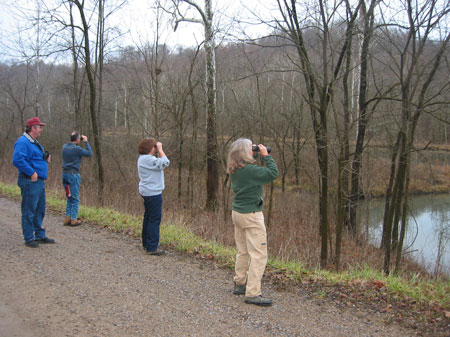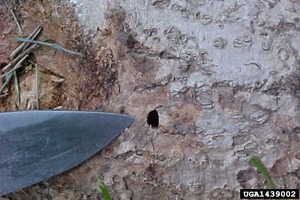 |
|
 |
 |
Bird Counters Asked to Look for Invasive Species
Each year, the Audubon Society Christmas Bird Count mobilizes more than 70,000 volunteers that count birds in more than 2,400 locations in the western hemisphere.
This year is the 115th year of the annual Christmas Bird Count, and is a fun and exciting way to learn more about the bird species that overwinter in your region. Reported information will be used to understand important information about the world's most imperiled bird species.
In addition to this information, the local counts have additional benefits. The long-term collected data helps researchers understand how birds are responding to climate change, changes in forest practices and the impact of invasive species.
Conservationists from dontmovefirewood.org, along with state officials across North America, are asking birders to also be on the lookout for invasive forest pests while birding and have a newly updated resource called a "Bird Watcher's Field Guide to Holes in Trees" to help.
Learn more at The Nature Conservancy's Blog.
|
 |
'D' shaped emerald ash borer exit hole. Photo Credit: David R. McKay, USDA APHIS PPQ, Bugwood.org
|
 |
 |
Black Gold: Burning Landscapes to Improve Their Health
Hunters often wonder why their lands no longer produce as many deer or turkeys as they did in the past. Farmers often see reduced crop yield, their fields no longer producing the same amount and quality of product. Landowners also wonder why the beautiful native wildflowers that they grew up with have disappeared. Often, the answer is that they should be looking to their forest understory, grasslands and savannahs for the answer.
"The prairie landscapes of Texas historically were hit with wildfires every 3 to 12 years, so there are whole communities of native plants that need fires to be healthy," says Land Steward Michelle Bertelsen at the Lady Bird Johnson Wildflower Center.
Fire has been shown to be essential to maintaining healthy forests, grasslands and wildlife areas. Depending on the season and intensity, fire can help increase grasses available for grazing, reduce forest understory fuels before devastating uncontrolled wildfires and also reduce the presence of non-native invasive plant species.
A new video features the work of the Lady Bird Johnson Wildflower Center and other partners in their research and reintroduction of fire to central Texas. Learn more by visiting YouTube. |
 |
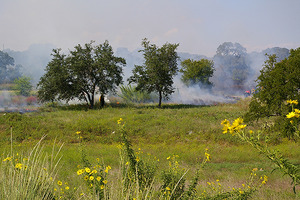
A 21-acre prescribed fire burned in late September, which should increase the diversity of wildflowers and control invasive grasses. Photo Credit: Lee Clippard, Lady Bird Johnson Wildflower Center

From Fire to Flowers: Prescribed Burns Heal the Land, a free YouTube feature.
|

|
 |
Invasive Spotlight:
Gypsy Moth
(Lymantria dispar)
Gypsy moth is one of North America's most devastating forest pests. Introduced from Europe and Asia, the gypsy moth was first found in America in the late 1800s near Boston, Massachusetts.
This species is especially problematic because it can feed on and defoliate hundreds of different tree species in North America, but prefers aspen (Populus) and oak (Quercus) species. This species can alter forest composition and eliminate sensitive host species.
Click here to watch an interesting video about the gypsy moth and its impacts.
Follow the link to learn more about gypsy moth. If you believe you have identified this pest, please REPORT IT. |
 |
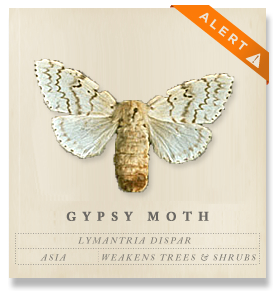
|
 |
 |
More News
Sixth Grader Makes Crucial, Scary Contribution to Invasive Species Science
Cheatgrass (Bromus tectorum), has been called one the most destructive plants in North America because it has replaced millions of acres of native grasses and herbs. Invasive grasses like cheatgrass are known to spread rapidly by attaching to vehicles, humans and animals. A sixth grader in California has now made a shocking discovery that will complicate prevention efforts around the world. Read more at KCET.
West Lake Hills Residents Free to Remove Invasive Plants and Trees
After months of expert opinions and residential input, residents of the West Lake Hills community in Travis County can now more easily address invasive plants and trees in their yards following a City Council revision to the City tree ordinance. Residents may now remove invasive species anywhere on their property by obtaining a free permit. Read more at the Statesman.
West Coast Faces Challenges from Tsunami Flotsam
Nearly three and a half years after the deadly 2011 Japanese tsunami, researchers are still finding flotsam on western beaches with potentially invasive species attached. Researchers with Oregon State University are especially concerned with the discovery of foreign crustaceans and mussels, because they could introduce new diseases or compete with native species. Read more at redOrbit.
Draft Impact Statement on National Feral Swine Damage Management Program Available
The US Department of Agriculture Animal and Plant Health Inspection Service has released a Draft Environmental Impact Statement evaluating strategies to manage the increasing damages and threats regarding the expanding population of feral swine nationally. USDA plans a collaborative, national management program to reduce feral swine damage. Read more at USDA APHIS Wildlife Damage.
New Technology Puts Dent in Feral Hog Problem
Texans have battled feral hogs for over a decade, as they face the damages created by the hogs to their land and crops. A new technology being used in north Texas could help turn the tide against the devastating nuisance. This new technology, called Total Animal Control (TAC), incorporates traps and a mobile device to lure them into one area where they are then trapped. Learn more in the Denton Record Chronicle.
Green Teacher Releases New Invasive Species Book to Assist Teachers
Whatever your role in educating youth, a new Green Teacher resource, "Teaching About Invasive Species" will provide innovative perspectives, program ideas, games and other activities to help convey messages about invasive species and develop engagement for young people from ages 6-19 years of age. Learn more at Green Teacher.
Climate Changes May Favor Invasive Wetland Plants
A new Duke University study has indicated that changing surface water temperatures, rainfall patterns and flow rates could provide excellent conditions for non-native, invasive plants to advance and further invade ecosystems. The study, funded by the EPA is the first large scale simulation to predict the effects to plant communities in the southeastern US. Read more at Nature World News.
USDA Publishes Review Decision for Biological Control of Asian Citrus Psyllid
The United States Department of Agriculture Animal Plant Health Inspection Service has published a decision document for the release of biological control agent, Diaphorencytus aligarhensis to control the Asian citrus psyllid in the continental United States. The Asian citrus psyllid is a biological host to the deadly citrus disease known as citrus greening or Huanglongbing (HLB). Read more at regulations.gov.
Consider the Invader: Minor Differences May Have Major Impact
Recently, scientists at SUNY Buffalo State investigated why two related species of invasive bivalves invade at different rates and have different levels of impact. Their findings indicate that minor differences between closely related invasive species may lead to far different impacts on the native communities into which they are introduced. Learn more at ScienceDaily.
If you would like your invasive species event or news listed in the next iWire, please send the details to iwire@texasinvasives.org.
|
 |
|
 |
 |
Scientist of the Month
Jon and Greg Rothlander
Jon Rothlander and his father, Greg, became interested in conservation when they learned their community is a registered Texas historical site. The Block House Municipal Utility District, near Cedar Park is the site of Fort Tumlinson, a Texas Revolutionary War fort that was built by men that later left to fight at the Alamo. This and other culturally sensitive areas containing evidence of past Native American occupation are now in a protected area in the community, which is being threatened by invasive species.
Jon, with the support of his father Greg, is working to identify, map and remove invasive plants from his community as part of a Boy Scout conservation project that he hopes will qualify for the Hornaday Award, the highest scouting award for conservation. Through this effort, Jon has documented invasive plant observations since he took the Invaders of Texas online training in August, followed by an in-person workshop in October at the Texas Master Naturalist Annual Conference.
In addition to the invasive species work, Jon and Greg will also be working with the MUD leadership to develop a master plan for the community that includes management of invasive species, promotion of native plants and for conserving water.
Keep up the great work, Jon and Greg. We applaud your work!
If you would like to highlight a successful invasive species project or nominate a special person to be highlighted in an upcoming iWire, please send the details to iwire@texasinvasives.org.
|
|
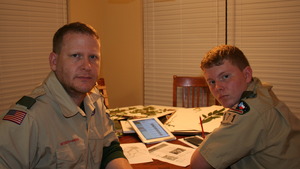
Greg Rothlander (Left) and Jon Rothlander (Right) with their collected specimens and Texas Invasives app.
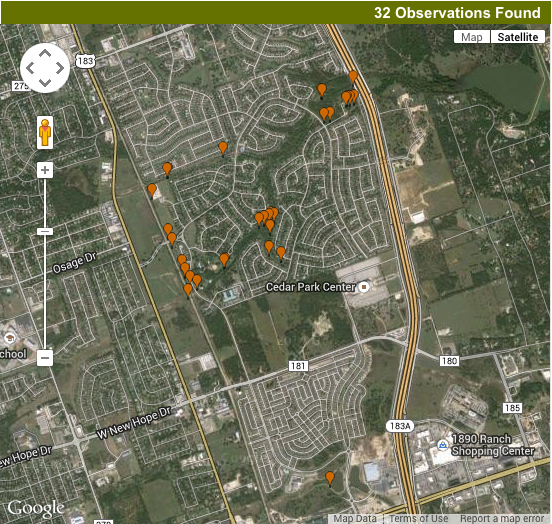
Jon Rothlander's Submitted Observations in his community, near Cedar Park, Texas. |
 |
 |
 |
Sentinel Pest Network and Invaders of Texas Species Workshops
Invaders of Texas workshops train volunteers to become citizen scientists to detect and report invasive species. Workshops include information on the Sentinel Pest Network which serves to increase the awareness of early detection of Emerald Ash Borer, Cactus Moth, Asian Longhorned Beetle, and other pests of regulatory significance.
Workshops are tailored to meet the interests of your volunteer group, and supplementary session examples include an introduction to the TX Invaders mobile application and the Eradicator Calculator, a feature on Texasinvasives.org designed to help organize and track volunteer-based eradication efforts.
We have funding from USDA APHIS and the Texas A&M Forest Service for more workshops in the upcoming months, so schedule your free workshop, today!
Upcoming Workshops:
Saturday, January 17, 2015
Location: High Island Volunteer Fire Department (High Island, TX)
Contact: Richard Gibbons
Saturday, February 28, 2015
Location: Texas Invasive Species Institute (Huntsville, TX)
Contact: Ashley Morgan
Saturday, March 13, 2015
Location: Jesse H Jones Park & Nature Center (Humble, TX)
Contact: Rose Holmes
For more information or to register to attend a workshop, please visit the Workshop Page.
|
 |
 |
|


